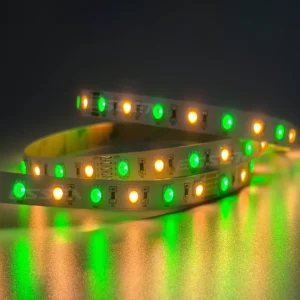Osoitteellinen (digitaalinen) DMX512 & SPI LED-valonauhat valot
Osoitteelliset (digitaaliset) DMX512- ja SPI-LED-valonauhat ovat osoitteellisia LED-valonauhoja, jotka tarjoavat kehittyneitä ohjausominaisuuksia dynaamisten valotehosteiden luomiseen.
Osoitteelliset (digitaaliset) DMX512-LED-nauhavalot käyttävät DMX512-protokollaa tiedonsiirtoon, kun taas SPI-LED-nauhavalot käyttävät SPI:tä (Serial Peripheral Interface) tiedonsiirtoon. Ne mahdollistavat jokaisen LEDin yksilöllisen ohjauksen, mikä mahdollistaa värien, kirkkauden ja efektien tarkat säädöt.
DMX512- ja SPI-LED-nauhavalot mahdollistavat dynaamiset valaistuksen muutokset reaaliajassa, joten ne sopivat erinomaisesti näyttämöesityksiin, arkkitehtoniseen valaistukseen, tapahtumiin ja viihdetiloihin.
Osoitteelliset (digitaaliset) DMX512- ja SPI-LED-nauhavalaisimet tarjoavat monipuolisia, mukautettavia ja dynaamisia valaistusratkaisuja monenlaisiin sovelluksiin, näyttämöesityksistä ja arkkitehtonisesta valaistuksesta kaupallisiin tiloihin ja ulkoasennuksiin.
Tuotteen tiedot

UKK
Frequently Asked Questions and Reply about DMX512&SPI LED Strip Lights
What are DMX512 and SPI LED strip lights?
The DMX512 and SPI LED Strip Lights are types of addressable LED strip lights, that allow for individual control of each LED on the strip. DMX512 is a standard communication protocol widely used in professional lighting applications, while SPI (Serial Peripheral Interface) is a synchronous serial communication interface commonly used for LED lighting control.
How do DMX512 & SPI LED strip lights work?
DMX512 LED strip lights utilize the DMX512 protocol to receive control signals from a DMX controller or lighting console. SPI LED strip lights, on the other hand, use the SPI interface to receive data from a compatible controller or microcontroller. Both types of LED strip lights allow for precise control over color, brightness, and effects.
What are the main features of DMX512 & SPI LED strip lights?
DMX512 and SPI LED strip lights offer advanced lighting control capabilities, allowing users to create dynamic color-changing effects, patterns, and animations. They are ideal for stage lighting, architectural lighting, entertainment venues, and other applications where precise and synchronized lighting control is required.
Can I control DMX512 & SPI LED strip lights with a DMX controller?
Yes, DMX512 LED strip lights can be controlled using a DMX controller that supports the DMX512 protocol. Similarly, SPI LED strip lights can be controlled using SPI-compatible controllers or microcontrollers.
Are DMX512 & SPI LED strip lights compatible with RGB, RGBW, and other color configurations?
Yes, DMX512 and SPI LED strip lights are available in various configurations, including RGB (Red, Green, Blue), RGBW (Red, Green, Blue, White), and RGBWW (Red, Green, Blue, Warm White, Cool White). They offer flexible color options to suit different lighting design requirements.
Can I synchronize multiple DMX512 & SPI LED strip lights together?
Yes, multiple DMX512 and SPI LED strip lights can be synchronized together using a single DMX controller or master controller. This allows for seamless color transitions and coordinated lighting effects across multiple strips.
Are DMX512 & SPI LED strip lights suitable for outdoor use?
DMX512 and SPI LED strip lights are available in both indoor and outdoor versions. Outdoor-rated LED strips are designed to withstand harsh environmental conditions such as moisture, dust, and UV exposure, making them suitable for outdoor lighting applications.
What is the difference between DMX512 and SPI LED strip lights?
The main difference between DMX512 and SPI LED strip lights lies in the communication protocol used to control them. DMX512 is a standardized protocol primarily used in professional lighting systems, while SPI is a serial communication interface commonly used in LED control applications.












